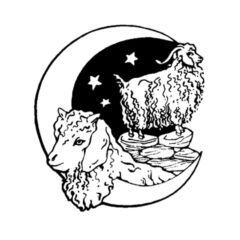Thur, May 29 Well, here we find ourselves on our penultimate day and at last a sunny warm one. For the first time we take the Outertown Road to Warbeth just north up the coast.. We park near the water and several cemeteries and walk along the beaches. Here we are in our Moonshine Design mohair socks–and not for the first time to be sure! .
In the distance we can just see the ruins of the palace built by the last bishop of Orkney at Breckness and right on the beach we come across a beautifully constructed cairn (modern). Here we sit for some time watching the birds and boats and soaking in the sun. The views out toward the cliffs of Hoy are spectacular.
We walk back to the cemetery (or cemeteries?) and I and a Glaswegian couple with the help of a groundskeeper who had attended the funeral spend quite some time trying to find the gravestone for the author Geogre Mackay Brown. We expect something larger and more showy so it takes a while for us to start focusing on the smaller stones. Success at last. I love the quote on it: Carve the runes then be content with silence
I suggest that we pay a final visit to the Ring of Brodgar and on the way, in Stromness we go to Julia’s, a cafe that has been recommended to us. The cappucino is excellent as are the pastries. Michael makes a quick trip to the Harray Potter to try to discover more about the knife maker or his knives but no further light in shed on their provenance .
The Ring is far less forbidding in the sun and of course the warmth has brought out a swarm of tourists. We try to keep the mystery but it’s a bit difficult with people off a couple of tour buses everywhere shooting pictures. I preferred the brooding and dark, cold day with scudding clouds. Not far outside the Ring we notice very distinct mounds which turn out on inspection to be a couple of rabbit warrens–shades of Watership Down! The bunnies scamper about but I never seem to have my camera ready at the right time. 



From Brodgar we head once again into Kirkwall. and finally visit the Earl’s Palace and the Bishop’s Palace next door…and just across the street from the cathedral. The Earl’s Palace, begun in 1601 by Earl Patrick Stewart, was to be the Renaissance showpiece of Orkney and all Scotland but Patrick was a shady character (he didn’t pay for the sandstone brought in from the island of Eday, for example, and the builders were to all intents and purposes enslaved and unpaid as well. Within five years Patrick was deep in debt and nine years after, both he and his son were executed for treason. The palace complex was joined with the older Bishop’s residence and today is still a most imposing set of buildings.
We next pick up Lynn’s new ring from Alison Moore and around the corner Lynn and I each buy a small model of an Orkney chair. It’s an impulse buy and we both have slight buyer’s remorse though now I am happy I did buy it. It brings back many memories.
Back in Stromness I make dinner trying to use up as much as I can of the remaining food, all built around the wonderfully thick Dounby Butcher’s lamb chops:
Cynthia’s Last Supper
Prepare rice using chicken broth in place of half the water
Add cardamom pods, raisins and the remaining salad dressing Lynn had made
Chop and saute on large griddle
3 small sweet peppers
1 large onion
6 oz mushrooms
1/2 head of garlic
6 to 8 oz frozen lima beans
Push vegetables to the side and grill
5 lamb chops until they are just barely done…so tender!
There is no wine left so Michael makes himself and me a vodka plus sweet syrup in soda water drink.
We watch the sailboats out on Scapa Bay and Jill puts the bones from the lamb chops out on the back deck. Instantly a dozen gulls swoop in and we race to get our cameras. We try to entice them back using soggy water biscuits but they are not impressed. At least we have gotten a few photos.


















































































































































































